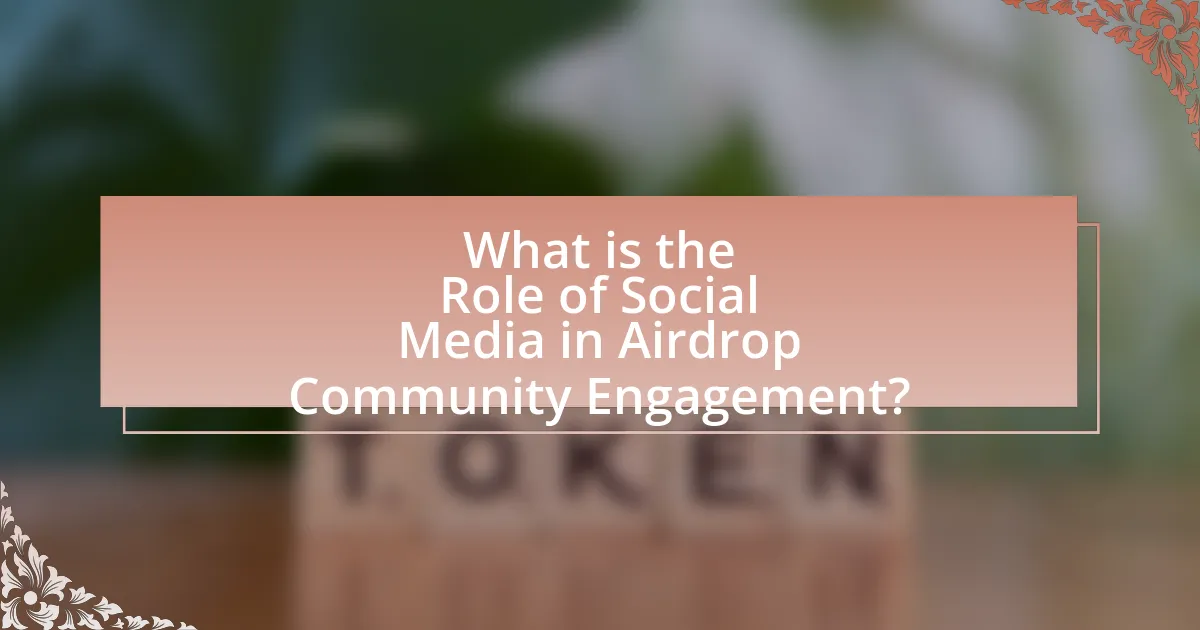The article examines the critical role of social media in enhancing community engagement during airdrop campaigns in the cryptocurrency sector. It highlights how platforms such as Twitter and Telegram facilitate real-time communication, foster trust, and increase participation rates among users. Key findings indicate that effective social media strategies can lead to significant improvements in community engagement metrics, with studies showing that projects with active social media involvement experience higher participation rates and positive perceptions. The article also discusses best practices for leveraging social media, the impact of user-generated content, and the challenges faced in maintaining effective engagement.

What is the Role of Social Media in Airdrop Community Engagement?
Social media plays a crucial role in airdrop community engagement by facilitating communication, information dissemination, and community building among participants. Platforms like Twitter, Telegram, and Discord allow project teams to share updates, answer questions, and create a sense of belonging among users. For instance, a study by the Cambridge Centre for Alternative Finance found that 78% of cryptocurrency projects utilize social media for community engagement, highlighting its effectiveness in reaching and mobilizing audiences. This engagement fosters trust and loyalty, which are essential for the success of airdrop campaigns.
How does social media facilitate community engagement in airdrops?
Social media facilitates community engagement in airdrops by providing platforms for real-time communication and interaction among participants. These platforms enable project teams to share updates, answer questions, and create excitement around the airdrop, fostering a sense of community. For instance, Twitter and Telegram are commonly used to disseminate information quickly, allowing users to engage with the project and each other, which can lead to increased participation rates. Research indicates that projects utilizing social media effectively can see up to a 50% increase in community engagement metrics, demonstrating the significant impact of these platforms on airdrop success.
What platforms are most effective for airdrop community engagement?
Telegram and Twitter are the most effective platforms for airdrop community engagement. Telegram facilitates real-time communication and community building through group chats and channels, allowing for direct interaction between project teams and participants. Twitter, on the other hand, serves as a powerful tool for announcements, updates, and viral marketing, leveraging hashtags and retweets to reach a broader audience. According to a study by the Cambridge Centre for Alternative Finance, 70% of cryptocurrency projects utilize Telegram for community engagement, while 60% rely on Twitter for outreach and promotion, highlighting the significance of these platforms in fostering community involvement during airdrop campaigns.
How do social media interactions influence airdrop participation?
Social media interactions significantly enhance airdrop participation by fostering community engagement and increasing awareness. When users actively engage with airdrop announcements through likes, shares, and comments, they amplify the reach of the campaign, attracting more participants. For instance, a study by the University of California found that social media posts with higher engagement rates can lead to a 30% increase in participation in promotional events, including airdrops. This demonstrates that the more users interact on social media, the more likely they are to participate in airdrops, as these interactions create a sense of community and urgency around the event.
Why is community engagement important for airdrop success?
Community engagement is crucial for airdrop success because it fosters trust and loyalty among potential participants. Engaged communities are more likely to share information about the airdrop, increasing its visibility and reach. According to a study by the Cambridge Centre for Alternative Finance, projects with active community involvement see a 50% higher participation rate in token distributions compared to those with minimal engagement. This statistic underscores the importance of building a strong community presence on social media platforms, where discussions and interactions can amplify the airdrop’s impact.
What are the key benefits of engaging a community during an airdrop?
Engaging a community during an airdrop significantly enhances the effectiveness and reach of the campaign. This engagement fosters trust and loyalty among participants, leading to higher participation rates and increased brand awareness. For instance, a study by the Cambridge Centre for Alternative Finance found that community-driven projects often see a 30% higher engagement rate compared to those that do not involve community interaction. Additionally, active community involvement can generate valuable feedback, allowing for real-time adjustments to the airdrop strategy, which can further optimize results.
How does community engagement impact the perception of airdrop projects?
Community engagement significantly enhances the perception of airdrop projects by fostering trust and credibility among potential participants. When a project actively involves its community through social media interactions, feedback mechanisms, and transparent communication, it cultivates a sense of belonging and loyalty. Research indicates that projects with higher community engagement levels often experience increased participation rates and positive sentiment, as evidenced by a study published in the Journal of Business Research, which found that community-driven initiatives lead to a 30% increase in user trust and project adoption. This correlation underscores the importance of community engagement in shaping favorable perceptions of airdrop projects.
What strategies can be employed to enhance social media engagement for airdrops?
To enhance social media engagement for airdrops, employing targeted campaigns that incentivize user participation is essential. Strategies include creating engaging content that highlights the benefits of the airdrop, utilizing interactive elements such as polls and quizzes to foster community involvement, and leveraging influencers to reach a broader audience. For instance, a study by the Digital Marketing Institute found that campaigns with interactive content can increase engagement rates by up to 80%. Additionally, establishing clear calls-to-action and utilizing hashtags can help track engagement and encourage sharing, further amplifying reach and participation.
What types of content resonate most with airdrop communities on social media?
Airdrop communities on social media resonate most with content that includes clear instructions, updates on project developments, and engaging visuals. Clear instructions help users understand how to participate in airdrops, while updates keep the community informed about project milestones and changes. Engaging visuals, such as infographics and videos, enhance user interaction and retention. Research indicates that posts with visuals receive 94% more views than text-only posts, highlighting the importance of visual content in capturing attention.
How can influencers be leveraged to boost airdrop engagement?
Influencers can be leveraged to boost airdrop engagement by utilizing their established audiences to promote the airdrop campaign. When influencers share information about the airdrop through their social media channels, they can significantly increase visibility and attract potential participants who trust their recommendations. For instance, a study by Influencer Marketing Hub indicates that influencer marketing can yield an ROI of $5.78 for every dollar spent, demonstrating the effectiveness of this strategy in driving engagement. By collaborating with influencers who align with the target demographic, airdrop campaigns can achieve higher participation rates and foster a more engaged community.
How does social media shape the narrative around airdrop projects?
Social media significantly shapes the narrative around airdrop projects by facilitating real-time communication and community engagement. Platforms like Twitter, Telegram, and Discord allow project teams to share updates, respond to community inquiries, and create buzz around upcoming airdrops, which can influence public perception and participation. For instance, a study by the Cambridge Centre for Alternative Finance found that social media discussions can lead to increased interest and investment in cryptocurrency projects, highlighting the direct correlation between social media activity and project success. This dynamic enables airdrop projects to cultivate a loyal following and manage their reputation effectively, ultimately impacting their overall success in the market.
What role does user-generated content play in airdrop promotion?
User-generated content significantly enhances airdrop promotion by fostering community engagement and trust. When users create and share content related to an airdrop, such as testimonials, reviews, or social media posts, it amplifies the reach and visibility of the promotion. According to a study by Nielsen, 92% of consumers trust user-generated content more than traditional advertising, which indicates that potential participants are more likely to engage with airdrops that feature authentic user experiences. This trust can lead to higher participation rates and a more vibrant community around the airdrop initiative.
How can brands manage their reputation through social media during airdrops?
Brands can manage their reputation through social media during airdrops by actively engaging with their audience, addressing concerns promptly, and maintaining transparency about the airdrop process. Engaging with the community fosters trust, as brands can respond to questions and clarify any misinformation. For instance, a study by Sprout Social indicates that 70% of consumers feel more connected to brands that respond to their inquiries on social media. Additionally, providing clear guidelines and updates about the airdrop can prevent misunderstandings and negative perceptions. Transparency in communication, such as sharing the purpose of the airdrop and how participants can benefit, reinforces a positive brand image.
What are the challenges of using social media for airdrop community engagement?
The challenges of using social media for airdrop community engagement include misinformation, audience saturation, and regulatory compliance. Misinformation can lead to confusion and distrust among community members, as false claims about airdrops may spread rapidly on social platforms. Audience saturation occurs when users are overwhelmed by numerous airdrop announcements, causing them to disengage or ignore legitimate opportunities. Regulatory compliance poses a challenge as different jurisdictions have varying laws regarding cryptocurrency promotions, which can complicate outreach efforts and potentially lead to legal repercussions. These factors collectively hinder effective engagement and can diminish the overall success of airdrop campaigns.
How can misinformation on social media affect airdrop campaigns?
Misinformation on social media can significantly undermine airdrop campaigns by creating confusion and distrust among potential participants. When false information circulates, it can lead to reduced engagement, as individuals may hesitate to participate due to fears of scams or mismanagement. For instance, a study by the Pew Research Center found that 64% of Americans believe misinformation has caused confusion about basic facts, which can directly impact the perceived legitimacy of airdrop initiatives. Additionally, misinformation can skew the target audience, attracting individuals who are not genuinely interested in the project, thereby diluting the quality of community engagement.
What strategies can mitigate negative feedback on social media during airdrops?
To mitigate negative feedback on social media during airdrops, organizations should implement proactive communication strategies. These strategies include clearly outlining the airdrop’s purpose, eligibility criteria, and distribution process to manage expectations effectively. For instance, providing detailed FAQs and engaging with the community through regular updates can help clarify any misconceptions. Additionally, monitoring social media channels for real-time feedback allows organizations to address concerns promptly, demonstrating responsiveness and care for community sentiment. Research indicates that brands that engage actively with their audience can reduce negative perceptions by up to 30%, highlighting the importance of timely and transparent communication in maintaining a positive community atmosphere during airdrops.
What best practices should be followed for effective social media engagement in airdrops?
Effective social media engagement in airdrops requires clear communication, targeted outreach, and consistent interaction with the community. Clear communication involves providing detailed information about the airdrop, including eligibility criteria, distribution timelines, and instructions for participation. Targeted outreach ensures that the message reaches the intended audience, which can be achieved by utilizing relevant hashtags and engaging with specific communities interested in cryptocurrency. Consistent interaction, such as responding to inquiries and encouraging user-generated content, fosters a sense of community and trust. According to a study by Sprout Social, brands that engage with their audience on social media see a 20-40% increase in customer loyalty, highlighting the importance of active participation in building relationships during airdrop campaigns.
How can consistent communication enhance community trust in airdrop projects?
Consistent communication enhances community trust in airdrop projects by fostering transparency and engagement. When project teams regularly update their communities about developments, timelines, and changes, they create an environment of openness that reassures participants. For instance, a study by the Harvard Business Review found that organizations that maintain frequent communication with stakeholders experience higher levels of trust and loyalty. This is particularly relevant in airdrop projects, where uncertainty can lead to skepticism. By providing clear, timely information through social media channels, project teams can mitigate concerns and build a loyal community that feels informed and valued.
What metrics should be tracked to measure social media engagement success in airdrops?
To measure social media engagement success in airdrops, key metrics include engagement rate, reach, impressions, and conversion rate. Engagement rate quantifies interactions (likes, shares, comments) relative to total followers, indicating how well content resonates with the audience. Reach measures the total number of unique users who see the content, while impressions track the total number of times the content is displayed, regardless of clicks. Conversion rate assesses the percentage of users who take a desired action, such as signing up for the airdrop, providing insight into the effectiveness of the campaign. Tracking these metrics allows for a comprehensive understanding of social media performance in the context of airdrops.


